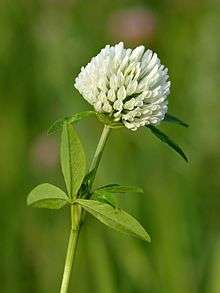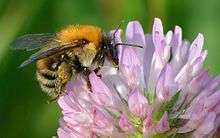Trifolium pratense
| Trifolium pratense | |
|---|---|
 | |
| Scientific classification | |
| Kingdom: | Plantae |
| (unranked): | Angiosperms |
| (unranked): | Eudicots |
| (unranked): | Rosids |
| Order: | Fabales |
| Family: | Fabaceae |
| Subfamily: | Faboideae |
| Genus: | Trifolium |
| Species: | T. pratense |
| Binomial name | |
| Trifolium pratense L. | |
Trifolium pratense, the red clover,[1][2] is a herbaceous species of flowering plant in the bean family Fabaceae, native to Europe, Western Asia and northwest Africa, but planted and naturalised in many other regions.
Description



It is a herbaceous, short-lived perennial plant, variable in size, growing to 20–80 cm tall. The leaves are alternate, trifoliate (with three leaflets), each leaflet 15–30 mm long and 8–15 mm broad, green with a characteristic pale crescent in the outer half of the leaf; the petiole is 1–4 cm long, with two basal stipules that are abruptly narrowed to a bristle-like point. The flowers are dark pink with a paler base, 12–15 mm long, produced in a dense inflorescence, and are mostly visited by bumblebees.[3]
Distribution
The red clover is found natively in Europe, Western Asia, and northwest Africa, but it has been naturalized in other continents, like North and South America. Specifically, the red clover was brought to Argentina and Chile over 100 years ago, although it is not clear how exactly it was introduced.[4] The red clover has become increasingly important as a source of economic stability in Chile, which has made the need for pollinators even more important.[5] One important pollinator, which was also brought from Europe, is Bombus ruderatus, or the large garden bumblebee. This bumblebee has been one of the important pollinators of red clover in South America and other countries like New Zealand.[6]
Uses
It is widely grown as a fodder crop, valued for its nitrogen fixation, which increases soil fertility. For these reasons, it is used as a green manure crop. Several cultivar groups have been selected for agricultural use, mostly derived from T. pratense var. sativum. It has become naturalised in many temperate areas, including the Americas and Australasia as an escape from cultivation.
Red clover is commonly used to make a sweet-tasting herbal tea.[7] It is an ingredient in some recipes for essiac tea.
Medical uses of the plant
Trifolium pratense is used in traditional medicine of India as deobstruent, antispasmodic, expectorant, sedative, anti-inflammatory and antidermatosis agent.[8]
In alternative medicine, red clover is promoted as a treatment for a variety of human maladies, including coughs, disorders of the lymphatic system and a variety of cancers. However, according to the American Cancer Society, "available clinical evidence does not show that red clover is effective in treating or preventing cancer, menopausal symptoms, or any other medical conditions".[9]
Dietary amounts of red clover are safe, but medicinal quantities may cause rash-like reactions, muscle ache, headache, nausea, vaginal bleeding in women, and slow blood clotting.[10]
Red clover contains coumestrol, a phytoestrogen.[11] Due to its activity on oestrogen receptors, red clover is contraindicated in people with a history of breast cancer, endometriosis, ovarian cancer, uterine cancer, uterine fibroids or other oestrogen-sensitive conditions,[12] although some authors have suggested the high isoflavone content counteracts this, and even provides benefits in these conditions.[13]
Due to its coumarin derivatives, T. pratense should be used in caution in individuals with coagulation disorders or currently undergoing anticoagulation therapy.[14]
It is metabolised by CYP3A4 and therefore caution should be used when taking it with other drugs using this metabolic pathway.[15]
The constituents of red clover flowers has been examined and discovered to contain a compound called pratol & a new compound called trifolianal.[16]
Diseases
Red clover is subject to bacterial as well as fungal diseases, including the red clover rust, Uromyces trifolii-repentis var. fallens. Other problems include parasitic nematodes (roundworms) and viruses.
Symbolism
Trifolium pratense is the national flower of Denmark[17] and the state flower of Vermont.[18]
See also
References
- ↑ "BSBI List 2007". Botanical Society of Britain and Ireland. Archived from the original (xls) on 2015-02-25. Retrieved 2014-10-17.
- ↑ "Trifolium pratense". Natural Resources Conservation Service PLANTS Database. USDA. Retrieved 15 December 2015.
- ↑ Van Der Kooi, C. J.; Pen, I.; Staal, M.; Stavenga, D. G.; Elzenga, J. T. M. (2015). "Competition for pollinators and intra-communal spectral dissimilarity of flowers" (PDF). Plant Biology. doi:10.1111/plb.12328.
- ↑ Rosso, B. S.; Pagano, E. M. (2005-08-01). "Evaluation of Introduced and Naturalised Populations of Red Clover(Trifolium pratense L.) at Pergamino EEA-INTA, Argentina". Genetic Resources and Crop Evolution. 52 (5): 507–511. doi:10.1007/s10722-005-0777-z. ISSN 0925-9864.
- ↑ Arretz, P. V.; Macfarlane, R. P. (1986-01-01). "The Introduction of Bombus Ruderatus to Chile for Red Clover Pollination". Bee World. 67 (1): 15–22. doi:10.1080/0005772X.1986.11098855. ISSN 0005-772X.
- ↑ Morales, Carolina L; Arbetman, Marina P; Cameron, Sydney A; Aizen, Marcelo A (2013-07-15). "Rapid ecological replacement of a native bumble bee by invasive species". Frontiers in Ecology and the Environment. 11 (10): 529–534. doi:10.1890/120321. ISSN 1540-9295.
- ↑ "Red Clover Tea". SupplementSOS.com. Retrieved 2013-03-09.
- ↑ Limei Wang, Birgit Waltenberger, Eva-Maria Pferschy-Wenzig, Martina Blunder, Xin Liu, Clemens Malainer, Tina Blazevic, Stefan Schwaiger, Judith M. Rollinger, Elke H. Heiss, Daniela Schuster, Brigitte Kopp, Rudolf Bauer, Hermann Stuppner, Verena M. Dirsch & Atanas G. Atanasov (2014). "Natural product agonists of peroxisome proliferator-activated receptor gamma (PPARγ): a review". Biochemical Pharmacology. 92 (1): 73–89. doi:10.1016/j.bcp.2014.07.018. PMC 4212005
 . PMID 25083916.
. PMID 25083916. - ↑ "Red Clover". American Cancer Society. November 2008. Retrieved 22 September 2013.
- ↑ Red clover, WebMD.
- ↑ Bhagwat, Seema; Haytowitz, David; Holden, Joanne. "USDA Database for the Isoflavone Content of Selected Foods" (PDF). US Department of Agriculture. Retrieved 26 April 2015.
- ↑ Cornelia Bodinet & Johannes Freudenstein (2004). "Influence of marketed herbal menopause preparations on MCF-7 cell proliferation". Menopause. 11 (3): 281–289. doi:10.1097/01.gme.0000094209.15096.2b. PMID 15167307.
- ↑ Dean W. Roberts, Daniel R. Doerge, Mona I. Churchwell, Gonçalo Gamboa da Costa, M. Matilde Marques & William H. Tolleson (2004). "Inhibition of extrahepatic human cytochromes P450 1A1 and 1B1 by metabolism of isoflavones found in Trifolium pratense (red clover)". Journal of Agricultural and Food Chemistry. 52 (21): 6623–6632. doi:10.1021/jf049418x. PMID 15479032.
- ↑ W. Abebe (2002). "Herbal medication: potential for adverse interactions with analgesic drugs". Journal of Clinical Pharmacy and Therapeutics. 27 (6): 391–401. doi:10.1046/j.1365-2710.2002.00444.x. PMID 12472978.
- ↑ "Red clover (Trifolium pratense) Cautions - Epocrates Online". Online.epocrates.com. Retrieved 5 August 2012.
- ↑ Power, Frederick Belding; Salway, Arthur Henry (1910). "XXVI.—The constituents of red clover flowers". J. Chem. Soc., Trans. 97 (0): 231–254. doi:10.1039/CT9109700231. ISSN 0368-1645.
- ↑ "Other National Symbols". Embassy of Denmark, Washington DC. Archived from the original on 17 May 2007. Retrieved 3 April 2015.
- ↑ "Red Clover". Vermont Historical Society. Retrieved 3 April 2015.
Further reading
- Vleugels, Tim; Roldan-Ruiz, Isabel; Cnops, Gerda (April 8, 2014). "Influence of flower and flowering characteristics on seed yield in diploid and tetraploid red clover". Plant Breeding. 134 (1): 56–61. doi:10.1111/pbr.12224.
External links
| Wikimedia Commons has media related to Trifolium pratense. |
| Wikiversity has bloom time data for Trifolium pratense on the Bloom Clock |
- Red-clover seed production in the Intermountain States hosted by the UNT Government Documents Department
- Flora Europaea: Trifolium pratense
- Germplasm Resources Information Network: Trifolium pratense